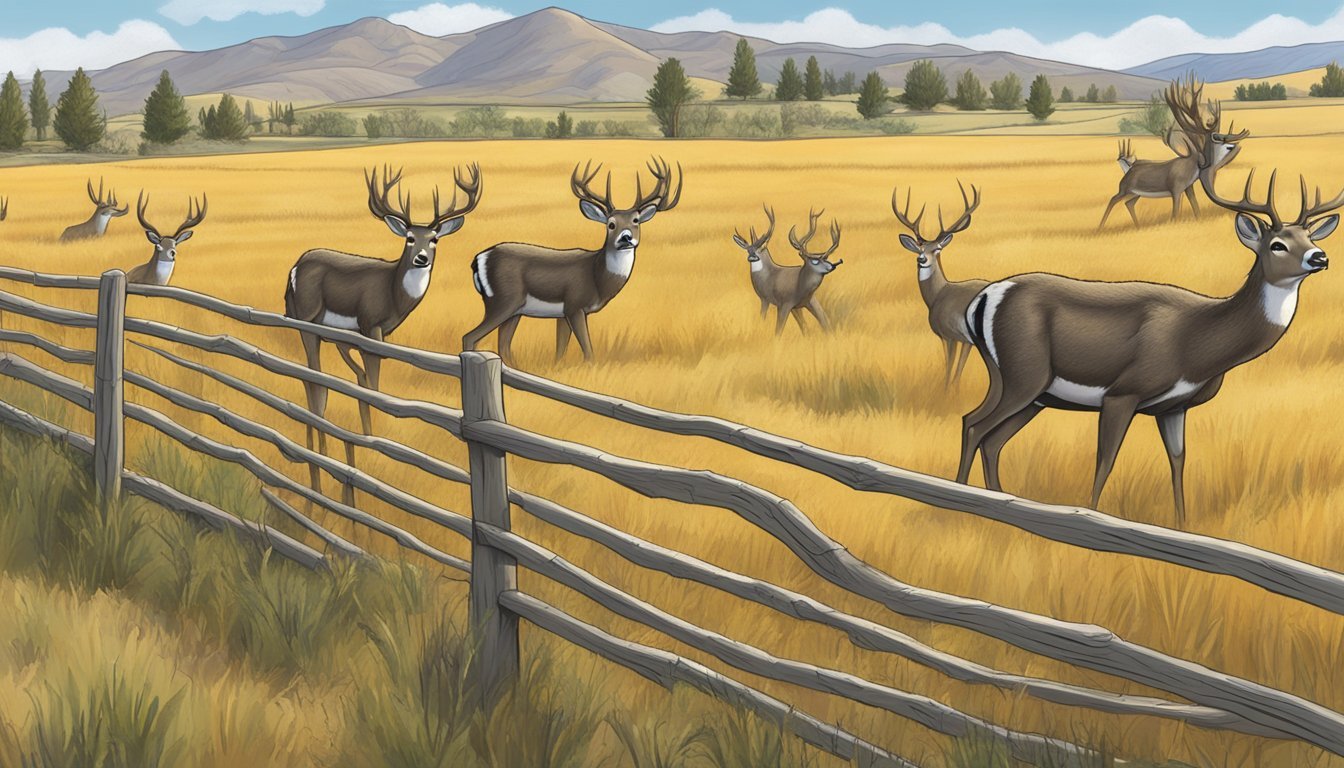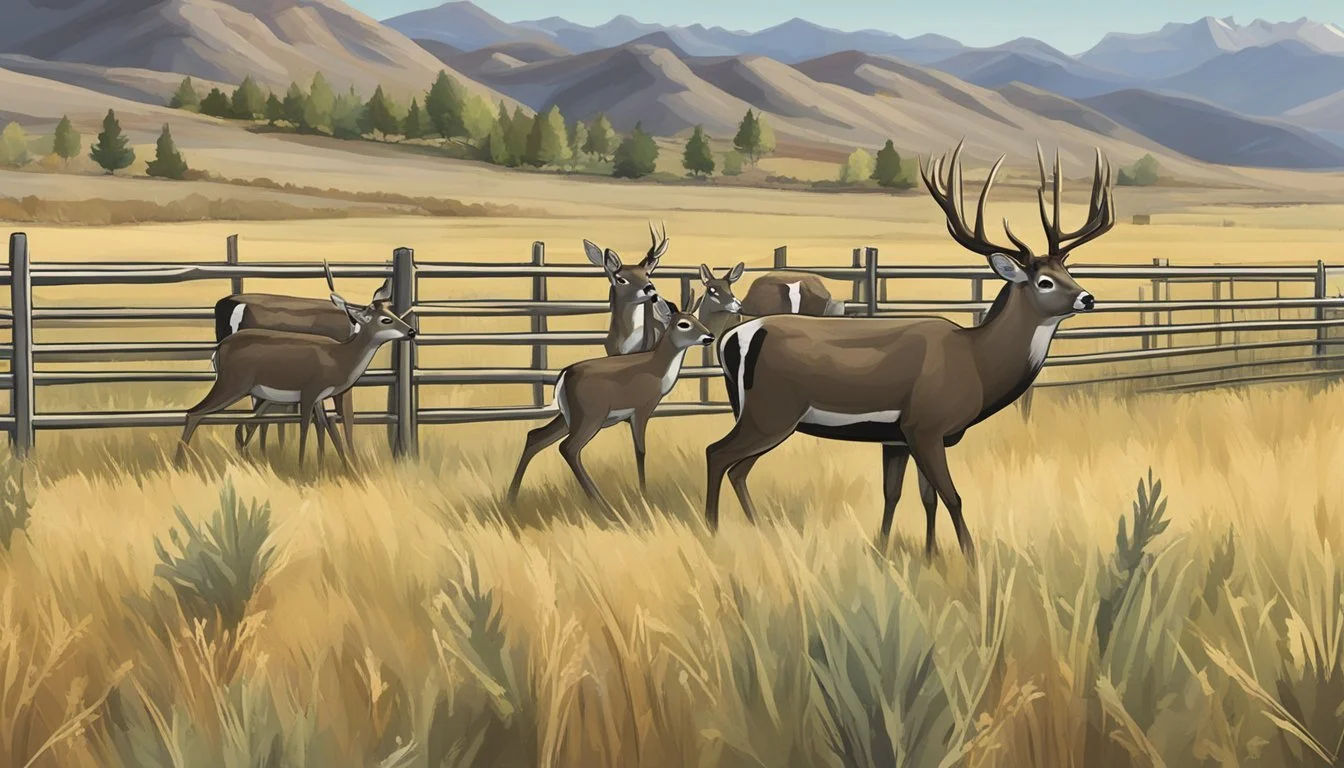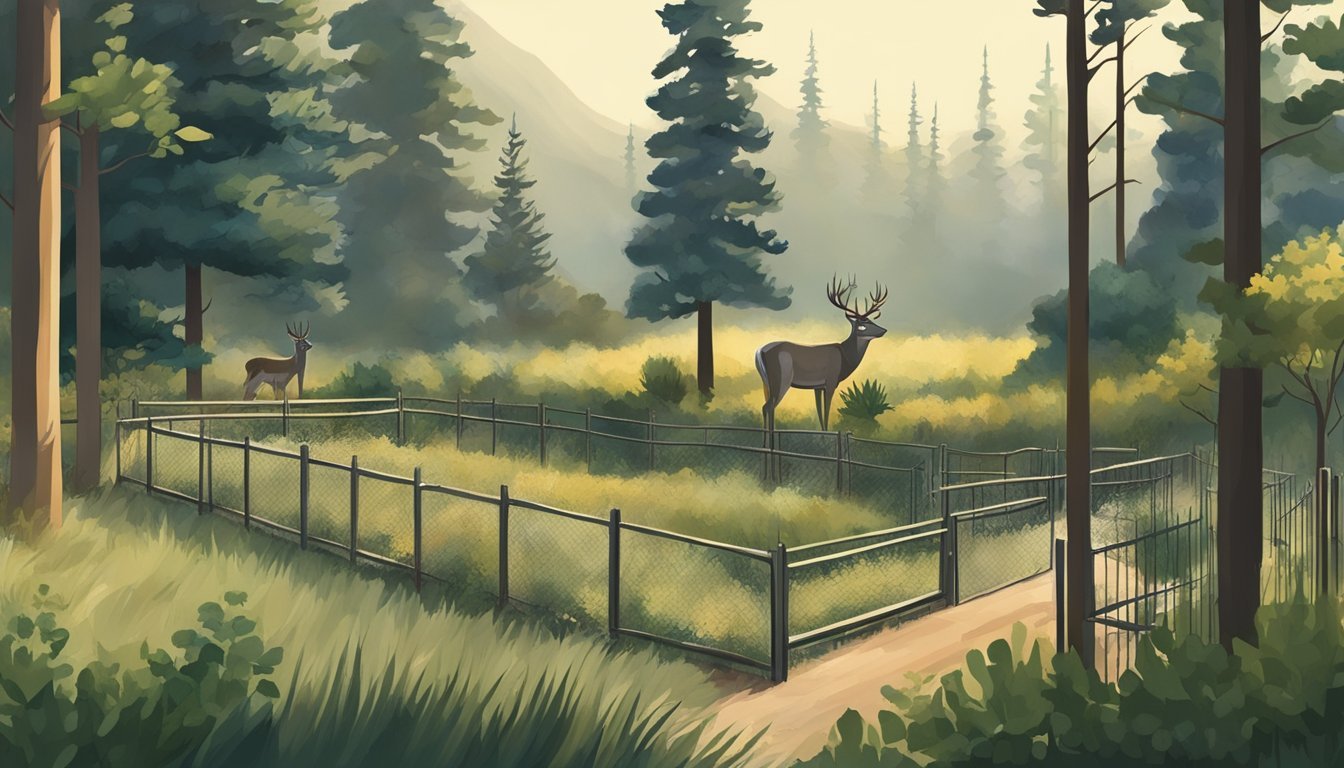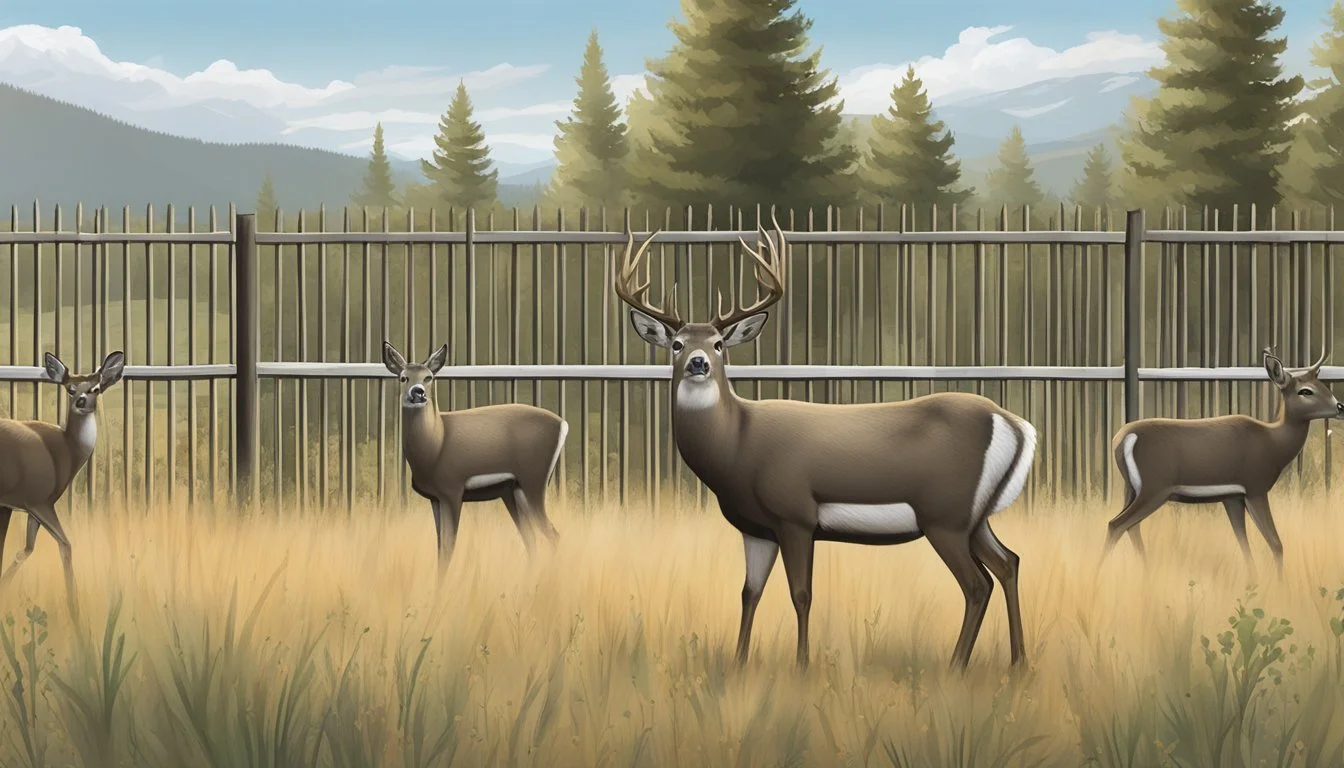Protecting Crops from Mule Deer
Effective Strategies for Farmers
Protecting agricultural investments from wildlife, particularly mule deer, is an essential task for farmers in regions where these animals are prevalent. Mule deer are known for their ability to adapt to various habitats, which often brings them into close contact with farmland. Their foraging can lead to significant crop damage, making it crucial for landowners to implement effective deterrent strategies.
Effective mitigation techniques combine a knowledge of mule deer behavior with physical barriers and repellents to minimize the impact on crops. Understanding the foraging patterns of mule deer allows farmers to predict when and where their crops are most vulnerable. This insight directs the strategic placement of fences, which are recognized as one of the most reliable methods to control deer damage.
In addition to structural solutions, there is a range of commercially available deer repellents that can deter mule deer without harming the animals or the environment. However, due to the adaptive nature of mule deer, an integrated approach involving a mix of physical deterrents, chemical repellents, and careful crop management is often required to protect agricultural yields effectively.
Understanding Mule Deer Behavior
When devising strategies to protect crops from mule deer, an in-depth understanding of their behavior is crucial. Behavior patterns such as diet, habitat preferences, and population dynamics directly impact their interactions with agricultural areas.
Diet and Feeding Patterns
Mule deer are primarily browsers; they feed on a variety of vegetation including shrubs, trees, and mast. Their diet shifts seasonally, relying on browse during the winter and richer crops and garden vegetation, such as corn, during the warmer months. This adaptability in diet can lead to mule deer finding nourishment within cultivation areas, which necessitates targeted wildlife management measures.
Habitat and Migration
The typical habitat of mule deer is in the wild stretches of the western U.S., including states like Colorado, Wyoming, Montana, and Idaho. They partake in seasonal migrations between their winter and summer ranges. This behavior is driven by food availability and environmental conditions; therefore, understanding migration patterns is essential for implementing effective conservation measures and minimizing crop damage.
Population Dynamics
Deer populations are subject to various factors that impact their survival and reproduction rates. Herds of mule deer are managed by wildlife agencies to ensure their conservation, and sustainable populations are integral to maintaining ecological balance. Effective wildlife management strategies reflect the dynamic nature of mule deer populations and their importance in the ecosystem.
Assessing Deer Impact on Agriculture
The impact of mule deer on agriculture can be extensive, affecting both the quality and quantity of crops through browsing and trampling. Landowners face economic challenges and limitations in safeguarding their land against persistent deer damage.
Types of Crop Damage
Mule deer cause damage to agricultural crops primarily through two methods: browsing and trampling. Browsing refers to deer eating the shoots, leaves, and stems of plants, often leading to reduced yield or total loss of the crops. Notably, deer tend to feed on the outer rows of crops, affecting the field's overall productivity. Trampling occurs when deer move through crop fields, and their hooves crush plants underneath, which can affect large portions of a field, even beyond the areas browsed.
Economic Implications for Landowners
For landowners, the economic implications of deer damage can be significant. The costs arise not only from the direct loss of crop yield but also from the potential reduction in land value and the investments required for effective deer management strategies, like building and maintaining fences. A scenario depicting the economic impact might involve a 200-acre soybean field with a 40% loss on 20% of the field due to deer, which can equate to considerable financial loss.
Challenges in Crop Protection
Protecting crops from deer damage presents various challenges. Physical barriers like fences can be effective but may represent substantial financial and logistical investments. A common limitation is that not all landowners can afford fencing, which is often required to encompass the perimeter entirely to be effective. Moreover, deer can sometimes breach these defenses, making protection against them a persistent battle. Landowners must balance the cost of crop protection measures with the economic losses caused by deer damage to make viable decisions.
In conclusion, deer present a variety of challenges to agricultural production, causing significant ecological and economic impact. Effective management practices, consideration of local deer populations, and adoption of innovative deterrents are essential to minimize crop loss and ensure sustainable agricultural practices.
Effective Fencing Strategies
When protecting crops from mule deer, employing effective fencing strategies is crucial. The choice of fencing greatly impacts the long-term viability of crop protection efforts.
Types of Fences for Deer Exclusion
Permanent Fences:
Wire Mesh: Often used because of its durability and effectiveness.
Woven Wire: A common choice offering strong barriers against deer.
Temporary Fences:
Electric: Can deter deer with a psychological barrier rather than a physical one.
Cattle Panels: Useful for quick setup and relocation as needed.
Pros and Cons of Fencing
Advantages:
Durability: Permanent fences such as woven wire can last many years.
Effectiveness: Properly installed barriers ensure that deer cannot access the crops.
Disadvantages:
Cost: Initial investment for materials and installation can be significant.
Maintenance: Requires regular checks to ensure integrity, especially after extreme weather events.
Implementation and Maintenance
Installation:
Adhere to local regulations and guidelines during the construction phase.
Fences should be at least 8 feet high to effectively prevent deer from jumping over.
Maintenance:
Regularly inspect and repair any breaches or weak points.
Ensure gates are closed and fences are maintained to preserve their protective properties.
Alternative Deer Deterrents
When protecting crops from mule deer, it's essential to employ a multifaceted approach. Various deterrents from chemical to physical can offer protection against these persistent grazers.
Chemical Repellents and Sprays
Chemical repellents and sprays function as taste and smell deterrents to mule deer. Commercial sprays containing ingredients like putrescent egg solids, capsaicin, or garlic oil can be effective if applied and re-applied according to package instructions. For a more targeted approach, predator urine serves as a powerful olfactory deterrent, signaling the presence of a threat to the deer.
Physical and Visual Barriers
Physical barriers arguably provide the best protection for crops. Fences should extend partly underground and have no gaps larger than 6x6 inches. Trunk protectors can guard individual trees against bucks that rub their antlers against the bark. Additionally, installing visual barriers such as netting or tall plants that block the view of your garden can also help deter deer.
Auditory and Olfactory Strategies
Auditory and olfactory strategies use a deer's acute senses against them. Scare tactics like unexpected noises can startle deer temporarily. However, deer can become accustomed to these noises if they are not varied. Alongside auditory deterrents, mixing in different scent-based repellents can maximize efficacy, as deer rely heavily on their sense of smell. Consider rotating different fragrance-based deterrents to prevent deer from growing desensitized.
Landscape Management and Plant Selection
The key strategies in protecting crops from mule deer involve careful selection of resistant plants and deliberate modification of the landscape to discourage deer presence. Effective plant selection can mitigate damage, employing both native and non-native species known for their resistance to deer browsing. By altering the habitat, one can create an environment that naturally deters deer, and cultivating alternative food sources may redirect them away from valuable crops.
Using Deer Resistant Plants
One proactive approach to crop protection is introducing deer resistant plants. A robust list of such plants includes certain grasses, like tall fescue, and floral species like lavender. These plants are typically aromatic, have a bitter taste, or are of a texture that deer find unappealing. The choice of these species can be particularly critical in landscaping to safeguard adjacent crops.
Deer Resistant Plants Attributes Russian Sage Aromatic, unpalatable Lamb's Ear Fuzzy texture Boxwood Low preference for deer
Altering Habitat to Deter Deer
Habitat modification can be a silent guard against mule deer intrusion. By manipulating the landscape through strategic placement of mast-producing trees or dense, thorny bushes, one can create natural barriers. Designing a landscape that limits easy access to crops by thick underbrush or uneven ground may discourage deer from entering the area.
Consider the following habitat alterations:
Physical barriers of prickly plants or uneven terrain.
Removal of deer pathways or bedding areas near crops.
Cultivating Alternative Food Sources
Lastly, providing alternative food sources is an often-overlooked aspect of landscape management. By planting decoy food plots or managing areas with preferred native grasses and shrubs away from protected crops, mule deer may be less inclined to feed on cultivated plants. This approach seeks to strike a balance with the natural behavior of deer while safeguarding agricultural interests.
Examples of alternative food sources:
Clover fields
Native berry-producing shrubs
Regulatory and Community Actions
Protecting crops from mule deer involves a variety of strategies, including implementing hunting regulations and advancing conservation efforts with public funding, as well as fostering cooperation within local communities.
Hunting Regulations and Wildlife Management
Hunting provides a tool for managing mule deer populations to reduce crop damage. Regulated hunting is sanctioned by entities such as the Bureau of Land Management and state wildlife agencies, which set season dates, bag limits, and issue permits to ensure a balance between deer populations and their impact on the environment. Hunters play a crucial role in this process, as they help to maintain herd sizes that are sustainable for the ecosystem and agriculture alike.
Conservation Efforts and Public Funding
Conservation initiatives aim to preserve mule deer habitats while mitigating the impact on farmland. Funding for these efforts often comes from governmental sources, such as the Recovering America's Wildlife Act, which dedicates substantial resources to wildlife and habitat conservation projects. By allocating these funds, landowners and conservation organizations work together to support science-based wildlife action plans that balance conservation goals with agricultural interests.
Engaging with Local Communities
Encouraging dialogue between communities, landowners, and conservation groups is essential. These discussions can lead to cooperative efforts to manage residential and suburban development in ways that consider wildlife movement patterns and habitats. Responding to the expansion of homes and communities, proactive approaches such as establishing community guidelines for living in close proximity to wildlife can be developed to decrease conflicts between humans and deer.
Frequently Asked Questions
Protecting crops from mule deer involves implementing effective deterrent methods, appropriate fencing strategies, and understanding best practices for natural repellents and crop field security.
What effective methods can be used to prevent mule deer from entering agricultural lands?
To keep mule deer away from agricultural lands, farmers can deploy scare tactics such as noise devices, install motion-activated water sprayers, and place strategic barriers that hinder access. These can be used alone or in combination to reduce the likelihood of mule deer encroachment.
What types of deer fencing are recommended for fruit orchards?
For fruit orchards, high tensile wire or woven wire fencing that is at least 8 feet tall is often recommended to prevent deer from jumping over. Additionally, slanted or outrigger fences can enhance effectiveness by creating a psychological barrier for mule deer.
How can one deter deer from eating garden plants without causing them harm?
Non-toxic taste repellents and scent deterrents like soap bars and predator urine can discourage deer from eating garden plants. Mechanical deterrents like netting over plants or thorny branches placed around favored plants can also be effective without causing harm to the deer.
Are there any natural repellents proven to keep deer away from crops?
Certain plants, such as lavender and marigolds, have been reported to act as natural repellents for mule deer, due to their potent scents. Additionally, homemade sprays with ingredients like garlic or chili pepper have shown some effectiveness in deterring deer from crops.
Can employing hunting as a management tool aid in protecting crops from mule deer?
Managed hunting can be a tool in certain regions to help balance mule deer populations and protect crops. It is critical that any hunting program is carefully regulated to ensure it is sustainable and complements other management strategies.
What are the best practices for securing crop fields against deer encroachment?
The best practices for securing crop fields against deer include installing suitable fencing, employing guard animals, applying repellents, and creating less appealing conditions by removing tall weeds and potential hiding spots near fields. Regularly altering deterrent techniques can also help prevent deer from becoming accustomed to measures.








